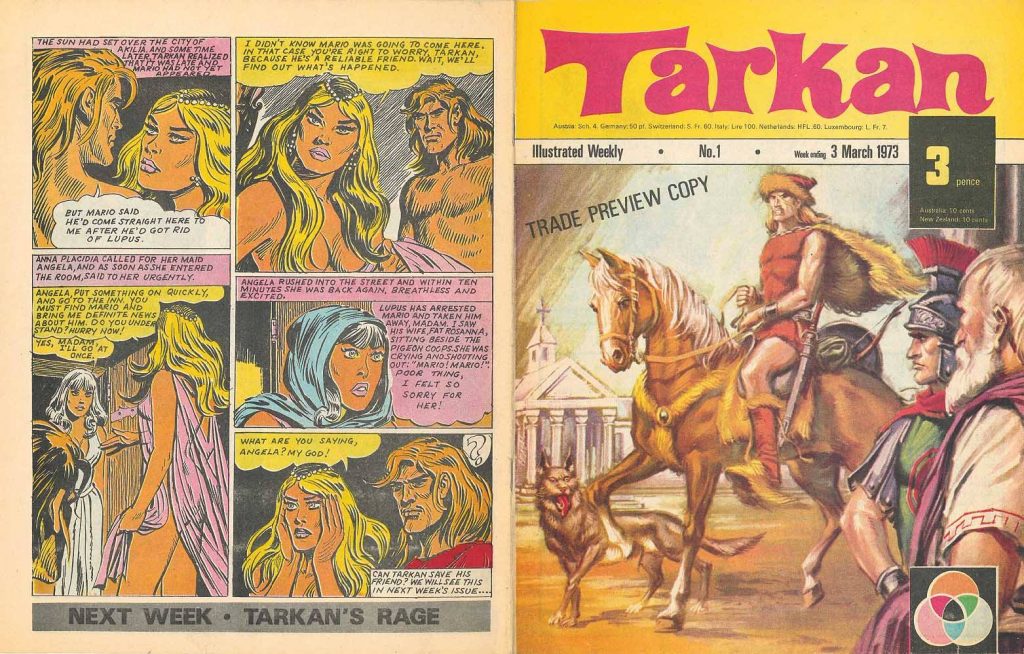
Preview pages of Tarkan #1, published in 1973 – a British reprint of a Turkish hero
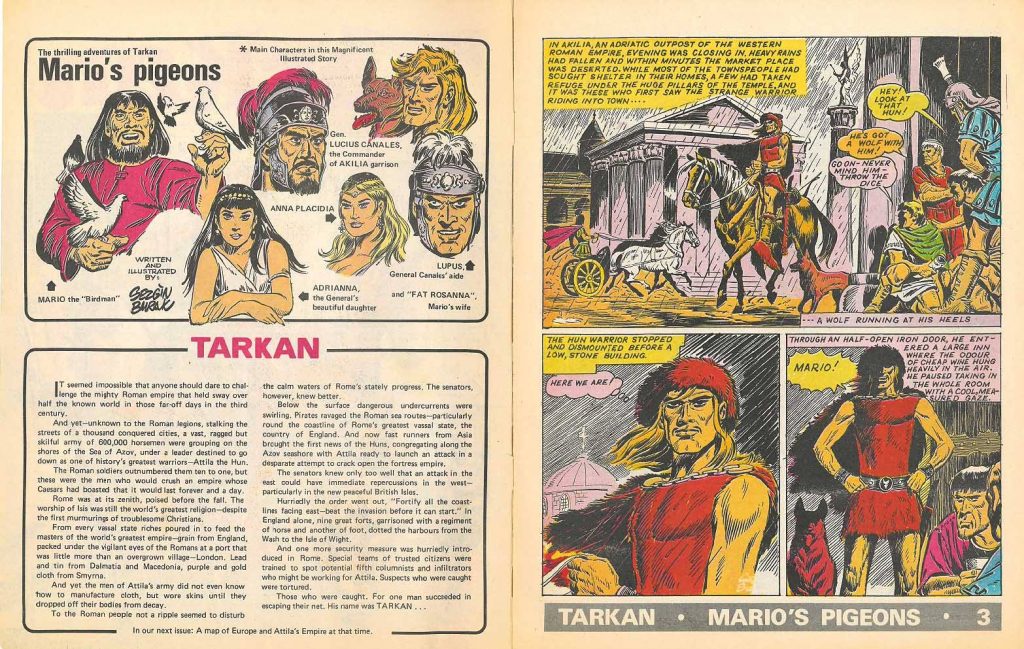
Almost every downthetubes visitor is a comic reader, but up until I came across an item on the Facebook Mighty World of British Comics group, to my shame, I had no idea comics reading once as popular in Turkey as I already knew it was in countries such as France, Italy, the US, UK, Japan, India or China (to name but a few).
Posted to the group was a cover image of a short-lived British reprint comic put out in the 1970s, Tarkan, utilising material featuring a character first published in Turkey. Comic artist and writer Lew Stringer featured it on his excellent comics blog back in 2007, reporting the comic launched in late February 1973 from Simavi Publishing, and lasted just 34 issues.
Details of the company are a bit sketchy, but between 1974 and 1975 they also published 27 issues of Super Sunday, “the Sunday newspaper for boys and girls”, which sounds like a 1970s version of the Children’s Newspaper or First News, and another short-lived title, Photo Romance, which apparently lasted just ten issues.
“The weekly British comic featured just 16 pages, half the length of a 32 page IPC comic, but all in full colour (albeit flat and slightly off-register colour),” notes Lew. “Most UK comics at that time would be mostly black and white, but Tarkan‘s flimsy format still made it look poor value in comparison.”
On exploration of the web, it turns out that while Tarkan’s UK adventure may have been short-lived, the British edition was launched at around the same time as a German edition by the same publisher, which fared better, running for 100 issues published in German-speaking countries. The Comic Book Database notes issues 94-100 were only distributed in Austria and Switzerland and are extremely rare, with Issue One cover dated 8th March 1973.
In Turkey, Tarkan was even more popular, and it this discovery also shed some light on comics culture there, which I was previously unaware of.
Some of you who have been on holiday to Turkey in recent years might be surprised by to learn about the country’s rich comics culture. (Until this weekend, I had only associated the name Tarkan for eexample with the Turkish singer, whose “Şımarık” proved such as hit it was covered by several other artists around the world, including Holly Vallance as “Kiss Kiss”, who made it a UK Number One).
It’s hardly surprising I didn’t know about these comics, though. On my own visits to local shops in tourist towns such as Yalikavak and Bodrum in the past, I didn’t see many comics on sale at all. It turns out I’d have had more luck if I’d visited cities like Istanbul, which has its own comic shops. (The first Istanbul Comics & Art Festival took place just last year).
According to Mark Berringer’s acdemic tome, Comics as a Nexus of Cultures, comics, both US imports and homegrown, were – and, for many, still are – a massive part of popular culture, and an article on the web site SouthEast Europe: People and Culture notes Turkish comic fans have eclectic taste. Many embrace Italian heroes of the 1960s and 1970s (exemplified by the Bonelli heroes Zagor and Mister No), heroes of the Belgian comics (Asterix, Tintin and Lucky Luke), as well as the American larger-than-life superheroes of DC and Marvel.
A love of the comic form certainly isn’t dead – and new comics are also being published (although it appears there’s not too much self publishing). Back in 2011, journalists Fehmi Demirbağ and Hasan Taşkın launched HeroTürk, the adventures of a Turkish child hero , a character living in 13th century Beijing during the reign of Kublai Khan, as both books, comics and, hopefully, film.
 The comic is written by Ahmet Sekendiz and drawn by Fatih Okta and sees the little hero and his culturally diverse friends travel in time on a historically rich journey, meeting the likes of Marco Polo and Ottoman Sultan Mehmed II.
The comic is written by Ahmet Sekendiz and drawn by Fatih Okta and sees the little hero and his culturally diverse friends travel in time on a historically rich journey, meeting the likes of Marco Polo and Ottoman Sultan Mehmed II.
According to Demirbağ, the Turkish comic book heroes of the 1960s and 1970s were “all created for grown-ups. There was a lack of a Turkish hero appealing to children. HeroTürk is the first Turkish child hero.”
With a club consisting of six children from different nations, including Greece, China and Nigeria, the creators hoped the comic book would enhance Turkey’s image abroad, although in part, just like Takan creator Sezgin Burak almost fifty years earlier, they also hoped HeroTürk would prove a popular, homegrown character to rival popular heroes from other countries.
Part of the income from HeroTürk, which has had the support of various government officials, including the Turkish Prime Minister, has been used in the establishment of a HeroTurk Children’s Hospital. An annual “HeroTürk of the Year” award, to reward the positive behaviour of children, is part of the project.
These revelations prompted me to do a bit of digging specifically about Tarkan, the comic character who’d inspired my trip downthetubes to find out more about Turkish comics.
For those in the dark about any of this comics culture, Tarkan is a fourth century Hunnic warrior serving for Attila the Hun. Born as the son of a Hunnic warlord in the Caucasus Mountains, Tarkan’s parents are slaughtered when he is an infant. Like Mowgli or Romulus and Remus, he is then raised by wolves, growing up to be a solitary warrior, his only companion a wolf, called simply Kurt (which is Turkish for wolf).
Creator Sezgin Burak, a professional comics artist since 1952, conceived the idea for Tarkan when he was working for the art agency Studio D’Ami in Italy in the mid-1960s. (He’d previously created the comic character “El Cougar”, drawn for the comic Kolosso). The first “Tarkan” strip was published in the daily Hürriyet in 1967, while Burak, his work influenced by Guido Crepax, was living in Milan, and ran for nine years.
In 1970, the adventures of Tarkan were published separately as a weekly comic book, the source of material published in English by Simavi Publishing in 1973, and proved so popular they led to a string of films from 1969 to 1973, starring Kartal Tibet as Tarkan in all but two, sadly only available in the UK on NTSC format import.
The first of these films was directed by veteran director Tunç Başaran and was a faithful adaptation of the very first Tarkan adventure, The Sword of Mars.
While Burak (who, I’ve learnt, sadly ended his own life in 1978 despite an impressive career, which also brought an end to Tarkan’s story, too) might perhaps in part have taken his inspiration for Tarkan from the success of Robert E. Howard’s Conan the Barbarian, and many of the adventures are pretty wild, the writer did plenty of research into the Huns (official Turkish history considers Huns to be the ancestors of modern Turks), and this helped in the conception of Tarkan.
The comic is considered the most popular of several comics of the 1960s referred to as Heroes with Swords, all inspired by motifs from the histories of Turks and Islam, which also include the comics Karaoğlan and Malkoçoğlu.
While Tarkan may not have proved much of a success in the UK back in 1973, he was clearly so in Turkey (and other countries), and all his adventures were re-published in hardback collections in 2010 by Turkish publisher Turkuvaz – all 21 adventures over 15 volumes, the strips originally published between 1967 and 1978.
I’m grateful to the Mighty World of British Comics for an entertaining diversion of discovery. Do feel free to comment if you’re more familiar with Turkish comics and let our readers know what they should be looking out for – past and present!
Further Reading
• Comic Oddities: Tarkan by Lew Stringer
• Special Report: Comics in the Turkic World
The Beat goes looking for comics in the Turkic world – Turkey, Azerbaijan, Kazakhstan, Uzbekistan, Turkmenistan, and Kyrgyzstan
• Comic Vine has a guide to comics created and published in Turkey here, although it omits reference to reprints of series such as Flash Gordon, way back in the 1930s.
• Daily Sabah: Five Comic Shops in Istanbul
• Istanbul Comics & Arts Festival (English language version of site)
• Comics as a Nexus of Cultures by Mark Berringer
Features essays from various critical disciplines examine how comic books and graphic narratives move between various media, while merging youth and adult cultures and popular and high art. The articles feature international perspectives on comics and graphic novels published in the US, Canada, Great Britain, Portugal, Germany, Turkey, India, and Japan. Topics range from film adaptation, to journalism in comics, to the current manga boom
• Dennis Gifford’s Complete Catalogue of British Comics, published in 1985, includes an entry on the British Tarkan comic
• The modern collections of Tarkan, published by major Turkish media group Turkuvaz, are available to buy in Turkish here on Babil.com
• Derin Hakikatler charts Turkish popular culture on this Turkish blog, noting the rise in comic sales in recent years
The founder of downthetubes, which he established in 1998. John works as a comics and magazine editor, writer, and on promotional work for the Lakes International Comic Art Festival. He is currently editor of Star Trek Explorer, published by Titan – his third tour of duty on the title originally titled Star Trek Magazine.
Working in British comics publishing since the 1980s, his credits include editor of titles such as Doctor Who Magazine, Babylon 5 Magazine, and more. He also edited the comics anthology STRIP Magazine and edited several audio comics for ROK Comics. He has also edited several comic collections, including volumes of “Charley’s War” and “Dan Dare”.
He’s the writer of “Pilgrim: Secrets and Lies” for B7 Comics; “Crucible”, a creator-owned project with 2000AD artist Smuzz; and “Death Duty” and “Skow Dogs” with Dave Hailwood.
Categories: British Comics, Creating Comics, downthetubes News

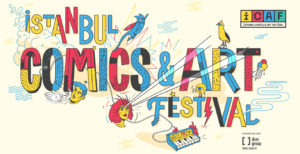
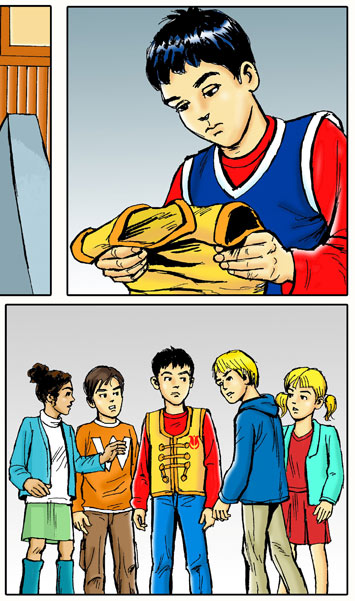
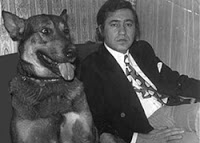
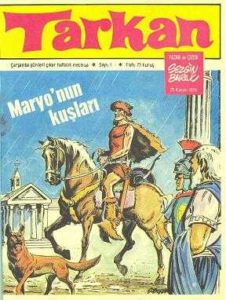
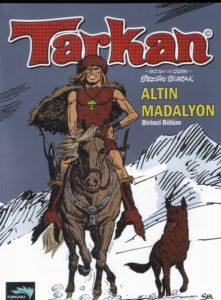
 The SEQUENT’ULL Interviews: Dan White
The SEQUENT’ULL Interviews: Dan White  Sports comic highlights an immortal rugby match
Sports comic highlights an immortal rugby match  The SEQUENT’ULL Interviews: Michelle Freeman
The SEQUENT’ULL Interviews: Michelle Freeman  The SEQUENT’ULL Interviews: Colossive Press
The SEQUENT’ULL Interviews: Colossive Press